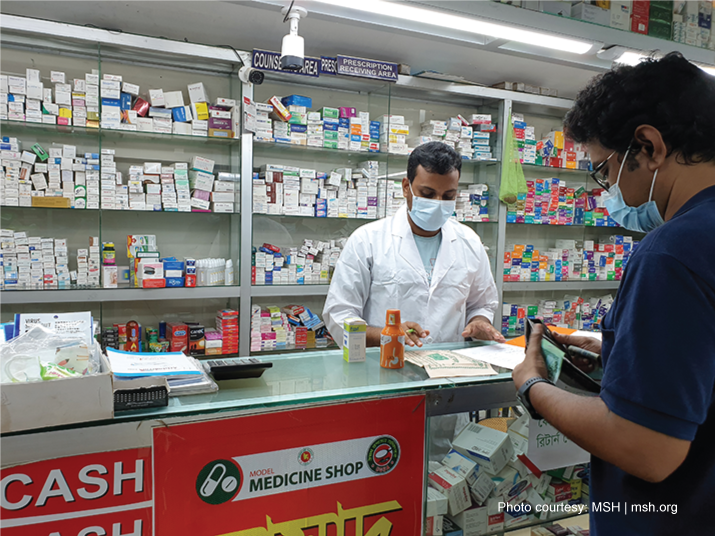
The pharmaceutical sector is one of the most remarkable industrial success stories of Bangladesh. In the 1980s, the country heavily relied on imported medicines to meet domestic demand. Today, the sector meets about 98% of local demand and exports to over 100 countries worldwide. It contributes nearly 2% to the country’s GDP and is expected to reach $6 billion by the end of 2025, driven by strong local investment, adoption of modern technology, rising per capita income, population growth, and supportive government policies. With high market readiness, rapid growth, and unique competitive advantages, the sector has been identified as a top immediate investment target in the latest FDI heatmap by BIDA.
This rapid growth and promising outlook, however, coexist with ongoing challenges in ensuring consistent quality and regulatory compliance across the sector, particularly at the pharmacy level. Weak regulation and lack of standardization across the country’s vast pharmacy network, especially among the majority of non-model pharmacies, pose risks such as poor quality control, inadequate record-keeping, and insufficient patient education.
The Model vs. Non-Model Pharmacy Standard Gap
There is a significant disparity between the operational standards of model and non-model pharmacies in Bangladesh. Model pharmacies follow strict guidelines including appropriate medicine storage, detailed record-keeping, and comprehensive patient counselling. On the other hand, non-model pharmacies often operate without trained personnel, lack standardized procedures, and function with minimal regulatory oversight. These inconsistencies compromise service quality and pose serious risks to public health.
To improve this situation, the Directorate General of Drug Administration (DGDA) introduced the concept of model pharmacies. These establishments are required to meet stringent criteria, such as maintaining an air-conditioned environment, using efficient stock management systems, and employing at least one qualified Grade A pharmacist who can provide patient counselling. Model medicine shops follow similar standards but may employ a Grade C pharmacist.
Nevertheless, the majority of pharmacies in Bangladesh remain non-model. According to DGDA, there are 173,525 licensed pharmacies in the country, with estimates suggesting up to 100,000 unlicensed outlets. Among the licensed facilities, only 234 are model pharmacies and 51,439 are model medicine shops. Most non-model pharmacies do not employ trained pharmacists, rarely maintain records, and often store medicines improperly. These practices include selling prescription drugs without proper authorization and mishandling sensitive medications.
Evidence from the Field
A 2024 study by Innovision Consulting on quality management practices revealed significant differences between model and non-model pharmacies. In model pharmacies, 90.32 percent of staff actively educate customers, while only 73.91 percent do so in non-model pharmacies. Moreover, the widespread absence of prescription assessment and retention hampers effective tracking of medicine use, which is critical for managing chronic illnesses that demand strict adherence to prescribed dosages.
Why Regulation and Record-Keeping Matter
Requiring pharmacies to maintain prescription records, either in print or in digital format, can significantly improve the monitoring of medication use and patient outcomes. This is especially important in managing chronic diseases and preventing the overuse, underuse, or misuse of medicines.
Interactions between pharmacists and patients also play a vital role. In model pharmacies, 87.1 percent of staff provide counselling on proper medication use and adherence, compared to only 71.0 percent in non-model pharmacies. Counselling contributes directly to better treatment results, yet this critical service remains largely absent in most pharmacies across the country.
Recommended Interventions
Closing the regulatory and service quality gaps between model and non-model pharmacies requires a coordinated, multi-stakeholder approach. Key actions may include:
- All pharmacies should adhere to basic guidelines and enforce Good Pharmacy Practices (GPP) for medicine storage and patient care to ensure safety and efficacy.
- Pharmacies should keep logs of prescriptions to facilitate medicine tracking and patient monitoring.
- Every pharmacy should employ at least one qualified pharmacist trained to assess prescriptions and counsel patients.
- DGDA should increase inspections and enforce penalties for non-compliance.
- Campaigns should inform consumers about the benefits of regulated pharmacies to drive demand for higher service standards.

Embracing Digital Solutions
For long-term transformation, investing in digital prescription management systems is vital. Digital tools can enhance traceability, reduce medication errors, prevent over-prescription, and support better adherence. Moreover, real-time monitoring of drug usage trends can significantly strengthen regulatory oversight. Training pharmacists to effectively use these tools and expanding digital infrastructure will be crucial steps in modernizing pharmaceutical service delivery.
Author: Soumik Siddique Plaban, an Associate in the Data Analytics & Emerging Frontiers Portfolio at Innovision Consulting